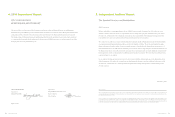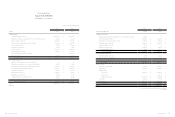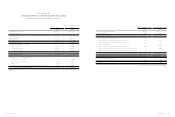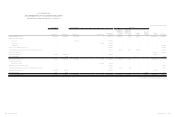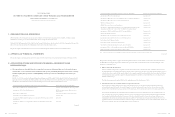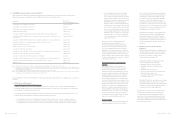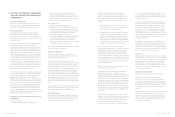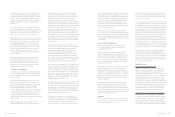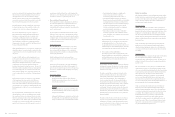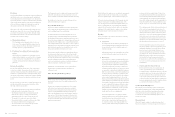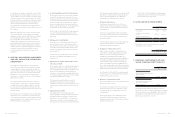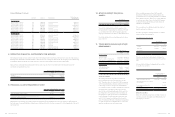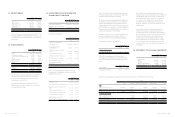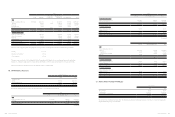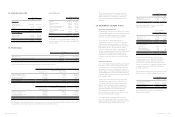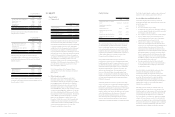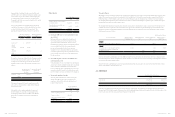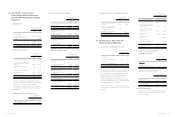HTC 2014 Annual Report Download - page 97
Download and view the complete annual report
Please find page 97 of the 2014 HTC annual report below. You can navigate through the pages in the report by either clicking on the pages listed below, or by using the keyword search tool below to find specific information within the annual report.
• Financial information Financial information •
190 191
losses, on the same basis as intangible assets that are acquired
separately.
Derecognition of intangible assets
Gains or losses arising from derecognition of an intangible
asset, measured as the difference between the net disposal
proceeds and the carrying amount of the asset, are recognized
in profit or loss when the asset is derecognized.
Impairment of Tangible and Intangible Assets
Other Than Goodwill
At the end of each reporting period, the Company reviews
the carrying amounts of its tangible and intangible assets,
excluding goodwill, to determine whether there is any
indication that those assets have suffered an impairment
loss. If any such indication exists, the recoverable amount of
the asset is estimated in order to determine the extent of the
impairment loss, if any. When it is not possible to estimate
the recoverable amount of an individual asset, the Company
estimates the recoverable amount of the cash-generating unit
to which the asset belongs. When a reasonable and consistent
basis of allocation can be identified, corporate assets are also
allocated to individual cash-generating units, or otherwise
they are allocated to the smallest group of cash-generating
units for which a reasonable and consistent allocation basis.
Intangible assets with indefinite useful lives and intangible
assets not yet available for use are tested for impairment at
least annually, and whenever there is an indication that the
asset may be impaired.
Recoverable amount is the higher of fair value less costs to
sell and value in use. If the recoverable amount of an asset or
cash-generating unit is estimated to be less than its carrying
amount, the carrying amount of the asset or cash-generating
unit is reduced to its recoverable amount.
When an impairment loss subsequently is reversed, the
carrying amount of the asset or a cash-generating unit is
increased to the revised estimate of its recoverable amount,
but so that the increased carrying amount does not exceed
the carrying amount that would have been determined had
no impairment loss been recognized for the asset (or cash-
generating unit) in prior years. A reversal of an impairment
loss is recognized immediately in profit or loss.
Financial Instruments
Financial assets and financial liabilities are recognized when a
group entity becomes a party to the contractual provisions of
the instruments.
Financial assets and financial liabilities are initially measured
at fair value. Transaction costs that are directly attributable
to the acquisition or issue of financial assets and financial
liabilities (other than financial assets and financial liabilities
at fair value through profit or loss) are added to or deducted
from the fair value of the financial assets or financial
liabilities, as appropriate, on initial recognition. Transaction
costs directly attributable to the acquisition of financial assets
or financial liabilities at fair value through profit or loss are
recognized immediately in profit or loss.
Financial assets
All regular way purchases or sales of financial assets are
recognized and derecognized on a trade date basis.
a. Measurement category
Financial assets are classified into the following
categories: Financial assets at fair value through profit
or loss, available-for-sale financial assets, and loans and
receivables.
1. Financial assets at fair value through profit or loss
(FVTPL)
Financial assets are classified as at fair value through
profit or loss when the financial asset is either held
for trading or it is designated as at fair value through
profit or loss.
A financial asset may be designated as at fair value
through profit or loss upon initial recognition if:
• Such designation eliminates or significantly
reduces a measurement or recognition
inconsistency that would otherwise arise; or
• The financial asset forms part of a group of financial
assets or financial liabilities or both, which is
managed and its performance is evaluated on a
fair value basis, in accordance with the Company’s
documented risk management or investment
strategy, and information about the grouping is
provided internally on that basis; or
• The contract contains one or more embedded
derivatives so that the entire hybrid (combined)
contract can be designated as at fair value through
profit or loss.
Financial assets at FVTPL are stated at fair value,
with any gains or losses arising on remeasurement
recognized in profit or loss. The net gain or loss
recognized in profit or loss incorporates any dividend
or interest earned on the financial asset and is
included in the ‘other gains and losses’ line item.
Fair value is determined in the manner described in
Note 28.
Investments in equity instruments under financial
assets at FVTPL that do not have a listed market price
in an active market and whose fair value cannot be
reliably measured and derivatives that are linked
to and must be settled by delivery of such unquoted
equity instruments are subsequently measured at cost
less any identified impairment loss at the end of each
reporting period and are recognized in a separate line
item as financial assets carried at cost. The financial
assets are remeasured at fair value if they can be
reliably measured at fair value in a subsequent period.
The difference between the carrying amount and the
fair value is recognized in profit or loss.
2. Available-for-sales (AFS) financial assets
AFS financial assets are non-derivatives that are
either designated as AFS or are not classified as
(i) loans and receivables, (ii) held-to-maturity
investments or (iii) financial assets at FVTPL.
Changes in the carrying amount of AFS monetary
financial assets relating to changes in foreign
currency exchange rates (see below), interest income
calculated using the effective interest method and
dividends on AFS equity investments are recognized
in profit or loss. Other changes in the carrying
amount of AFS financial assets are recognized in other
comprehensive income and accumulated under the
heading of investments revaluation reserve. When
the investment is disposed of or is determined to be
impaired, the cumulative gain or loss that previously
accumulated in the investments revaluation reserve is
reclassified to profit or loss.
Dividends on AFS equity instruments are recognized
in profit or loss when the Company’s right to receive
the dividends is established.
Available-for-sale equity investments that do not have
a quoted market price in an active market and whose
fair value cannot be reliably measured and derivatives
that are linked to and must be settled by delivery of
such unquoted equity investments are measured at
cost less any identified impairment loss at the end of
each reporting period and are presented in a separate
line item as financial assets carried at cost. If, in a
subsequent period, the fair value of the financial
assets can be reliably measured, the financial assets
are remeasured at fair value. The difference between
carrying amount and fair value is recognized in other
comprehensive income on financial assets. Any
impairment losses are recognized in profit and loss.
3. Loans and receivables
Loans and receivables (including trade receivables,
cash and cash equivalent, other current financial
assets, and other receivables) are measured
at amortized cost using the effective interest
method, less any impairment, except for short-
term receivables when the effect of discounting is
immaterial.
Cash equivalent includes time deposits with original
maturities within three months from the date
of acquisition, highly liquid, readily convertible
to a known amount of cash and be subject to an
insignificant risk of changes in value. These cash
equivalents are held for the purpose of meeting short-
term cash commitments.
b. Impairment of financial assets
Financial assets, other than those at FVTPL, are assessed
for indicators of impairment at the end of each reporting
period. Financial assets are considered to be impaired
when there is objective evidence that, as a result of one or
more events that occurred after the initial recognition of
the financial asset, the estimated future cash flows of the
investment have been affected.
For financial assets carried at amortized cost, such as
trade receivables and other receivables assets are assessed
for impairment on a collective basis even if they were
assessed not to be impaired individually. Objective
evidence of impairment for a portfolio of receivables
could include the Company’s past experience of collecting
payments, an increase in the number of delayed payments
in the portfolio past the average credit period of 60 days,
as well as observable changes in national or local economic
conditions that correlate with default on receivables.
For financial assets carried at amortized cost, the amount
of the impairment loss recognized is the difference
between the asset’s carrying amount and the present value
of estimated future cash flows, discounted at the financial
asset’s original effective interest rate.
For financial assets measured at amortized cost, if, in a
subsequent period, the amount of the impairment loss
decreases and the decrease can be related objectively to



